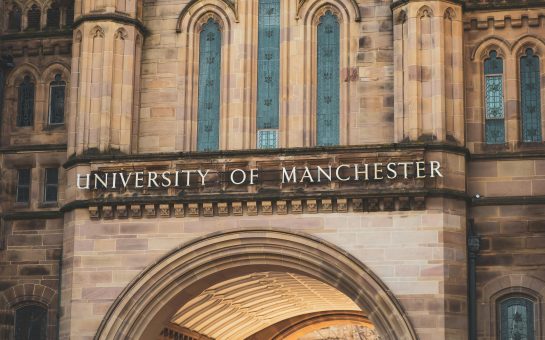University of Manchester economist Dr Xiaobing Wang outlined “physical capital, human capital and raw labour” as the factors which will see China overtake the United States as the world’s largest economy over the next decade.
Xiaobing has worked as a Senior Economics Lecturer at the University of Manchester since 2007, at which point China’s economy was the third-largest in the world, behind the US and Japan.
In 2007, US GDP was around $14 trillion, while Japan’s was $4.5 trillion and China’s was $3.5 trillion. Fast forward 13 years, US GDP has grown to $21 trillion. Meanwhile, China’s GDP has more than quadrupled to now stand at just over $14 trillion.
As of 2020, the US and China are way out in front as the world’s two largest economies, accounting for around 40 percent of global GDP.
When asked if it was only a matter of ‘when’ and not ‘if’ China’s GDP will eclipse America’s, Xiaobing’s immediate response was “yes,” adding: “China will be able to take over the US economy from two fronts, one is more deterministic factors and then some other more risky factors.”
In January 1979, Deng Xiaoping became the first leader to visit the US; where he announced to President Jimmy Carter that China was ready to open up business with the west.
Since then, China’s GDP has shot up from $150 billion in 1979 to $14.1 trillion today, meaning their real GDP has experienced an average annual growth rate of around 10 percent per year.
Over the same period, US GDP has grown from $2.5 trillion to $21 trillion but has only experienced an average annual GDP growth rate of one-and-a-half percent per year.
Dr Wang told MM: “Normally, economists understand the world in this simple way – physical capital, human capital and raw labour.
“The first factor is physical capital. The savings rate in China has been 40 percent over the last 40 years, and the savings rate in America is about 15 percent over the years. So, China will accumulate more capital than America.
“Second factor, if you look at raw labour, i.e. the number of workers you have, then China has more.”
China’s population is close to 1.5 billion, which is four-and-a-half times greater than the population of the US (330 million), meaning the Chinese government is earning more income tax from its workforce – a workforce whose skill level is constantly growing year-by-year.
STEM graduates
The skill level, knowledge, experience and intelligence amongst the Chinese workforce has grown over the years, adding value to their organisations and country. This is known as human capital, and the growth in the value of China’s human capital has rapidly increased over the past few decades, as illustrated by the number of Chinese graduates.
In 2019, the number of graduates from China was 8.3 million – more than double the number of US graduates. Many Chinese graduates attained degrees in the STEM (Science, Technology, Engineering and Mathematics) subjects.
In 2016, 4.7 million Chinese graduates earned a STEM-related degree, two million more than second-place on the list – India (2.6 million). That same year, only 368,000 US students graduated with STEM-related degrees – only 7.8 percent of the number of STEM graduates from China.
“Then the third factor is human capital. Human capital normally means when somebody goes to university and graduates they are seen as ‘high skilled labour’ and somebody who hasn’t been to university are seen as ‘unskilled labour.’” Xiaobing explained.
During the Cold War (1945-91), the US seized the initiative in STEM technology by landing the first astronaut on the moon in July 1969, therefore winning the ‘Space Race’ against the Soviet Union.
Up until then, the US feared they were behind the Soviets in terms of STEM technology as the USSR produced the first artificial Earth satellite (Sputnik 1) in 1957 before they produced the first object to hit the moon in 1959.
In 1961, Yuri Gagarin became the first man in space, and two years later Valentina Tereshkova became the first woman in space before Alexei Leonov completed the first spacewalk in 1965.
Just as the USSR was doing back then, China are right now developing the future cutting-edge STEM technology, most notably 5G for smartphones. By 2025, China is projected to become the world’s largest 5G market and is predicted to account for more than two-thirds of all 5G connections.
The US may have won the ‘Space Race’ in the 1960s and won the Cold War in 1991 when the USSR collapsed but, if current trends continue, they are going to lose the technological arms race with China in the 2020s and consequently lose the US-China trade war.
“If we want to compare this type of human capital to that in production, it seems like you can look at two indicators,” Xiaobing said. “One is the total number of graduates from China. And the other is the number of graduates in the STEM subjects.”
In 2016, China had more STEM graduates than India, the US, Russia, Iran, Indonesia, Japan and the UK combined.
By 2030, the number of STEM graduates from China is predicted to increase by 300 percent. In comparison, the number of STEM graduates in the US and Europe is expected to increase by 30 percent over the next decade.
Xiaobing continued: “In 2030, the number of graduates in STEM subjects of China and India will be bigger than the rest of the world. This is not my prediction, this is a trend. China will be number one in STEM graduates, and then India will be number two.”
In 2019, China had around 10.5 million students studying outside their home country.
Chinese students are a huge export to countries outside of China, most notably the UK. There has been a 34 percent increase in the number of Chinese students in the UK over the past five years – a figure which is set to increase still.
The number of Chinese students studying in the UK is currently over 120,000.
“Chinese students, they come, and the amount of tuition fees they pay on average is £20,000 per year. Normally, the British students pay less than half of that,” Xiaobing said.
“If it’s economics or a science subject, it’s £24,000 or even £30,000. If it’s Physics or Business, it’s £25,000, so it’s much more expensive.
“Some people call this phenomenon a higher education deficit, or a higher education surplus depending on from which country you are looking at it.
“We can also discuss this in terms of human capital. Think of the number of students from China to the UK. Of course, this is now one of the UK’s biggest exports.
“But in terms of knowledge, the Chinese and the Indians they have a surplus.”
China’s Industrial Revolution
Geographically, China was at a disadvantage when the Industrial Revolution took off in Britain during the nineteenth century where the west could produce large amounts of coal to fuel the Industrial Revolution whilst China’s Qing Dynasty was in revolt.
In the twenty-first century, China have put themselves at a geographical advantage due to the population growth in their 15 ‘megacities,’ each of which has a population of over 10 million – there are only 47 such cities in the world.
The growth of China’s major cities over the years means they have become centres for rapid urbanisation, which has in turn given rise to an agglomeration effect whereby populations of urban areas have experienced exponential growth. Therefore, when producing goods, output increases by a larger proportion than the increase in inputs during the production process – known as increasing returns to scale.
For example, in the city of Shenzhen, the population has grown from just 20,000 to 12.5 million over the past 50 years and it is projected to climb past 15 million by 2035.
Over the same period, the population of China’s capital city Beijing has gone up five-fold to now stand at 21.5 million.
“Housing prices in Beijing are very similar to Chelsea in London” Xiaobing stated.
“Cities have a thing called an agglomeration effect. In Economics, we call it increasing returns to scale, i.e. with the number of people, if you have more people, it’s more efficient.”
Even though pretty much all current trends, which look like they are set to continue, suggests that China will inevitably overtake America’s giant economy; Xiaobing acknowledged that there’s some risk to this hypothesis concerning institutions.
He continued: “By enlarge probability, they will overtake in ten years but you can never be sure. The institutions of the west, some say their institutions are better and some say they’re worse.
“Institution is a factor because they (China) are not a democratic country. I’m not saying that democracy is the best or is better, I’m just saying how from the point of the view of the west, this proves a risk.
“So, political institutions and economic institutions, i.e. you can call it political instability. In China, if people start to feel unhappy with the company they may go out of work. This is a risk.”
Clash of cultures: Trump vs. Xi
The two men at the centre of this unprecedented economic trade war are US President Donald Trump and Chinese President Xi Jinping.
Since President Trump was elected into the White House back in 2016, the US economy has greatly improved, but this hasn’t stopped him from being critical of China’s economy on several occasions.
“We’re having a little squabble with China because we’ve been treated unfairly for many, many decades, for actually a long time and it should have been dealt with a long time ago. It wasn’t, but we’ll handle it now,” Trump said last May.
Trump’s view of China is shared across the US government, but the Chinese view is very different. Xiaobing explained the contrasting governmental stances on the trade war.
He said: “From an American point of view, they want to contain China’s growth and this is the consensus across the political elite.
“The action that America has taken against China is not that: ‘what Donald Trump wants to do, the Americans don’t.’ In America, the majority of the American elite, the American state from the Federal government, Trump’s view is their view. If you look at the congress, the state department, the Democrats and the Republicans, this is an agreement.
“From the Chinese perspective, it is different. The overall tune of Xi Jinping over the last one or two years is: ‘try to avoid confrontation, but we are not free.’ We do not want to confront, but if you want to fight we will do something.
Indeed, this was President Xi’s message back in November.
“We do not want to start a trade war, but we are not afraid,” Xi said. “When necessary, we will fight back, but we have been working actively to try not to have a trade war.”
The Mao factor
During the twentieth century, Sino-US relations were, at times, friendly and at other times frosty. Both nations fought on the same side in the Second World War to contain the expansionist threat of Imperial Japan, but after World War Two the People’s Republic of China under the Communist leadership of Mao Zedong went into a state of isolation from the rest of the world.
Although not actively involved in the Cold War, China was very much part of the Communist Eastern Bloc under Chairman Mao, who was the supreme leader of China between 1949 and 1976 and is still a key figure in Chinese society today.
“He (Mao) laid the foundations of modern China from a political front and an economic front,” Dr Wang explained.
“First of all, and this is universally recognised, Chairman Mao abused state capacity and further development because before Chairman Mao, China was in a position where everybody could beat them.
“Secondly, if you look at the economic front, Chairman Mao built a basic industrial economic system in China. In the Mao era, industry capacity increased dramatically.”
When Mao’s Communists eventually won the long leadership struggle against Chiang Kai-Shek’s Nationalists in 1949, China needed rebuilding from scratch and Mao did just that.
“Before Chairman Mao, China was a very weak state and everybody could bully them,” Xiaobing observed. “Chairman Mao built a state capacity which enables them to grow without being bullied.
“There was a very weak industry, concentrated amongst Eastern China. But after 30 years of development, China had a whole industrialist system and enough capital to lay the foundations for later reforms.
“Political firms state capacity and then on the economic part, industry capacity. This is what Chairman Mao contributed.”
Right now, the world must continue to contain the spread of coronavirus, which Xiaobing believes in the context of the US-China trade war doesn’t change anything.
He concluded: “The coronavirus doesn’t change anything, it just amplifies things a little bit.
“It’s like a two-horse race, and although one horse (the US) is out in front, the other horse (China) is running faster so they will catch up.”



